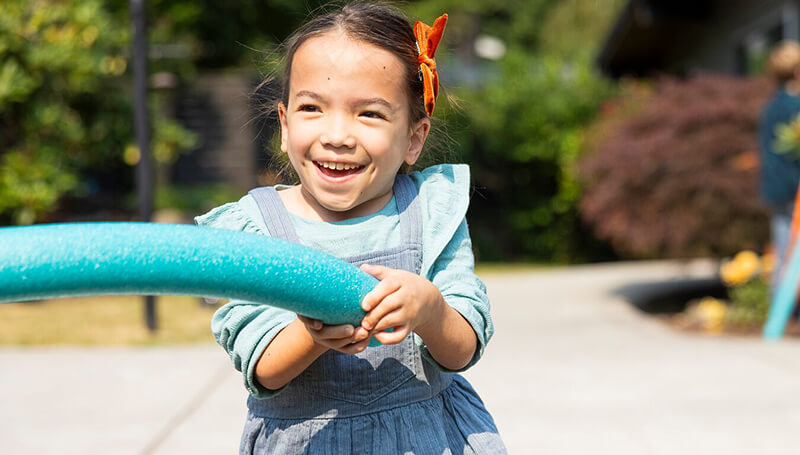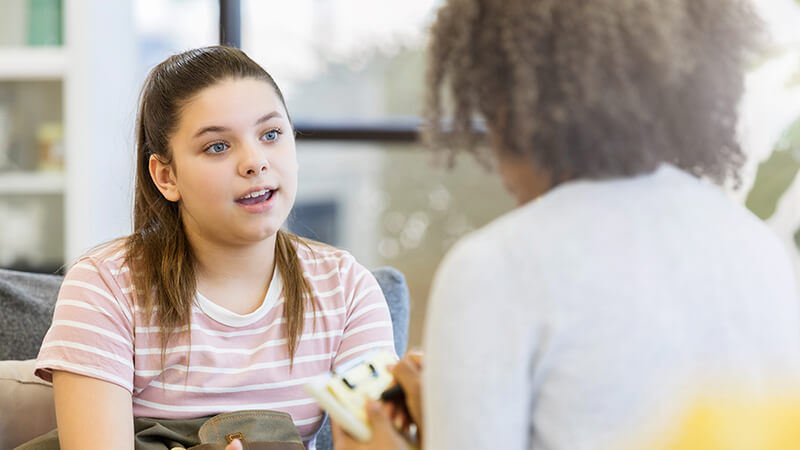Summer 2022
Discover the Benefits of Child-Directed Play
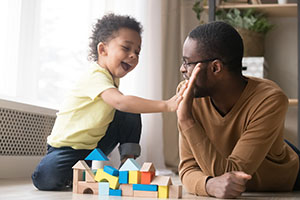 Child-directed play (CDP) is a special form of one-to-one play between a child and their parent or caregiver. During CDP, the child chooses and leads the activity while the parent is an active follower. While CDP is fun and valuable for all young children, it’s especially helpful for those with behavior challenges.
Child-directed play (CDP) is a special form of one-to-one play between a child and their parent or caregiver. During CDP, the child chooses and leads the activity while the parent is an active follower. While CDP is fun and valuable for all young children, it’s especially helpful for those with behavior challenges.
Research shows that child-directed play has many benefits. It builds a child’s feelings of self-direction and self-confidence while boosting their social skills and language development. It’s also an ideal way for a child to enjoy some positive, focused attention without having to misbehave to get it. Plus, CDP helps parents practice positive parenting skills and strengthen the parent-child bond.
Child-directed play is ideally done several times a week for no more than 10 to 15 minutes each time. You need a quiet place where there will be no distractions or interruptions — no TV, phone or other screens. Choose a time that is likely to be good for you and your child. Start by watching your child and then join them wherever they are and follow along with what they do. For example, if your child is lining up their toy cars, you might say, “Great idea! I’m going to line up cars, too.” Another favorite activity is doing an exciting play-by-play of your child’s actions, the way a sports announcer would do. And be sure to notice and praise behaviors you want to encourage, such as, “Wow, you’re stacking those blocks so calmly and carefully!”
Keep in mind that your role is to be a focused, fun, easygoing playmate — you’re not there to teach or direct or correct. And generally, during CDP, a child’s positive behavior gets lots of warm attention while negative behavior is ignored.
Learn more details on the benefits of CDP and how to do it.
Keeping Kids Hydrated
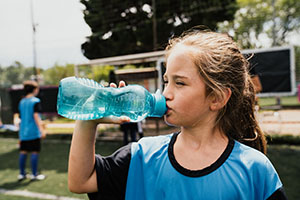 To keep our bodies and minds healthy, we must stay hydrated — and water is the best drink of all. Getting plenty of water is especially important for active kids, who may be too busy to think about it. Children ages 1 to 3 need about 4 cups of water a day. Children ages 4 to 8 need 5 cups a day, and older kids need 7 to 8 cups a day. These amounts may vary depending on their activity and weather conditions like heat and humidity.
To keep our bodies and minds healthy, we must stay hydrated — and water is the best drink of all. Getting plenty of water is especially important for active kids, who may be too busy to think about it. Children ages 1 to 3 need about 4 cups of water a day. Children ages 4 to 8 need 5 cups a day, and older kids need 7 to 8 cups a day. These amounts may vary depending on their activity and weather conditions like heat and humidity.
It’s important that kids drink before they feel thirsty, because thirst indicates you’re already at risk of dehydration. Be sure to bring water bottles with you everywhere and remind your child to drink several times an hour.
Kids who are especially active or playing a sport need more water. They should have 12 ounces 30 minutes before activity begins and at least 10 gulps every 20 minutes during. Plus, in the first hour after activity, they should have at least 10 gulps every 20 minutes.
Learn more about choosing water for healthy hydration.
Touch Supervision for Toddler Water Play
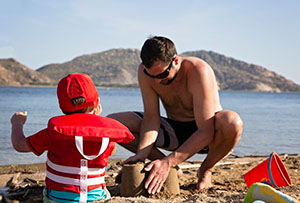 Drowning is the leading cause of unintentional death for children ages 1 to 4. Safety studies show that it’s very easy for caregivers to get distracted when they are supervising a toddler’s water play. This is true even when caregivers are just a few feet away. Since drowning can happen quickly and in very little water, safety experts recommend ‘touch supervision’ in and near the water. This means staying within arm’s length during bath time and swim time. During swim time, get in the water with your toddler. If you need to get out, take them with you — even if it’s just for a moment and even if lifeguards are nearby.
Drowning is the leading cause of unintentional death for children ages 1 to 4. Safety studies show that it’s very easy for caregivers to get distracted when they are supervising a toddler’s water play. This is true even when caregivers are just a few feet away. Since drowning can happen quickly and in very little water, safety experts recommend ‘touch supervision’ in and near the water. This means staying within arm’s length during bath time and swim time. During swim time, get in the water with your toddler. If you need to get out, take them with you — even if it’s just for a moment and even if lifeguards are nearby.
Whenever your child is in the water, give them your full attention. Don’t do anything that pulls your focus away, even for a moment. Don’t use your phone, tend the grill or do yard work or other chores. Avoid alcohol, which affects judgment and concentration.
Practice other layers of water safety, too. Supervision and a life jacket are two of the most important things you can provide to protect your child from drowning. It’s also essential to start swim lessons as soon as your child is ready.
When a toddler drowns, it’s typical that the caregiver hadn’t planned for the child to be in the water at all — and didn’t see the child go in. Also, it’s a myth that if a child falls in the water there will be lots of splashing and noise. The reality is that in most cases, children slip under quickly and silently, without being seen. Constant vigilance is the surest way to prevent a tragedy.
Learn more about water safety for children birth to 5 years.
Is That Belly Ache Appendicitis?
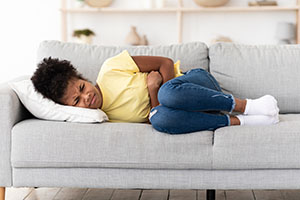 Kids can get belly aches for many reasons. But if the appendix is to blame, it’s a serious medical condition. So, it’s important to know the symptoms of appendicitis. Pain in the lower belly is the most common symptom. Children age 2 and younger are also apt to have vomiting and/or swelling in the belly. Older kids may report pain near their belly button, with the pain moving to the lower right. In most cases, the pain does not improve by lying still and movement tends to make the pain worse. Kids with appendicitis often do not want to eat, feel sick to their stomach, and may have vomiting and/or diarrhea. They may also have a fever and chills. If you suspect appendicitis, see a doctor right away.
Kids can get belly aches for many reasons. But if the appendix is to blame, it’s a serious medical condition. So, it’s important to know the symptoms of appendicitis. Pain in the lower belly is the most common symptom. Children age 2 and younger are also apt to have vomiting and/or swelling in the belly. Older kids may report pain near their belly button, with the pain moving to the lower right. In most cases, the pain does not improve by lying still and movement tends to make the pain worse. Kids with appendicitis often do not want to eat, feel sick to their stomach, and may have vomiting and/or diarrhea. They may also have a fever and chills. If you suspect appendicitis, see a doctor right away.
Rentable E-Scooters Are Not for Kids
 Rented electric scooters are sending people of all ages to emergency rooms. Broken bones are common, and so are serious head injuries because so few riders wear helmets.
Rented electric scooters are sending people of all ages to emergency rooms. Broken bones are common, and so are serious head injuries because so few riders wear helmets.
The American Academy of Pediatrics says that electric scooters are unsafe for all children under 16, whether they are drivers or passengers.
E-scooters are in many cities and they’re easy to rent with a smartphone app. Although scooter-share rental contracts make them legal only for riders age 18 and older, many younger kids rent them anyway. Talk with your tween or teen about the safety risks and be sure that those under 18 don’t have the app. If you use electric scooters, wear a helmet and never allow a child to ride with you.
Choices for the Win!
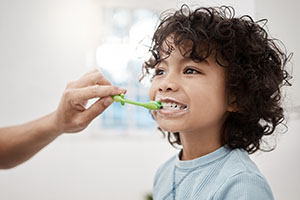 By using a method called ‘forced choice’ parents and caregivers can help kids cooperate and feel empowered at the same time. It involves giving a child two choices, either of which you’re happy with.
By using a method called ‘forced choice’ parents and caregivers can help kids cooperate and feel empowered at the same time. It involves giving a child two choices, either of which you’re happy with.
For example, rather than asking, “Will you please put on your coat before you go outside?” instead offer the choice, “Do you want to wear your blue coat or your red sweatshirt?” Or, rather than telling them, “It’s time to brush your teeth,” instead ask, “Do you want to brush your teeth before or after you put on your pajamas?”
Being able to choose helps kids feel they have some control over the situation. The forced choice method also avoids situations where you need to nag or negotiate with your child.
Learn more about child development and parenting.
Quick Tip
Young children have thin skin. To prevent scald burns, set your water heater to 120° F or lower.
